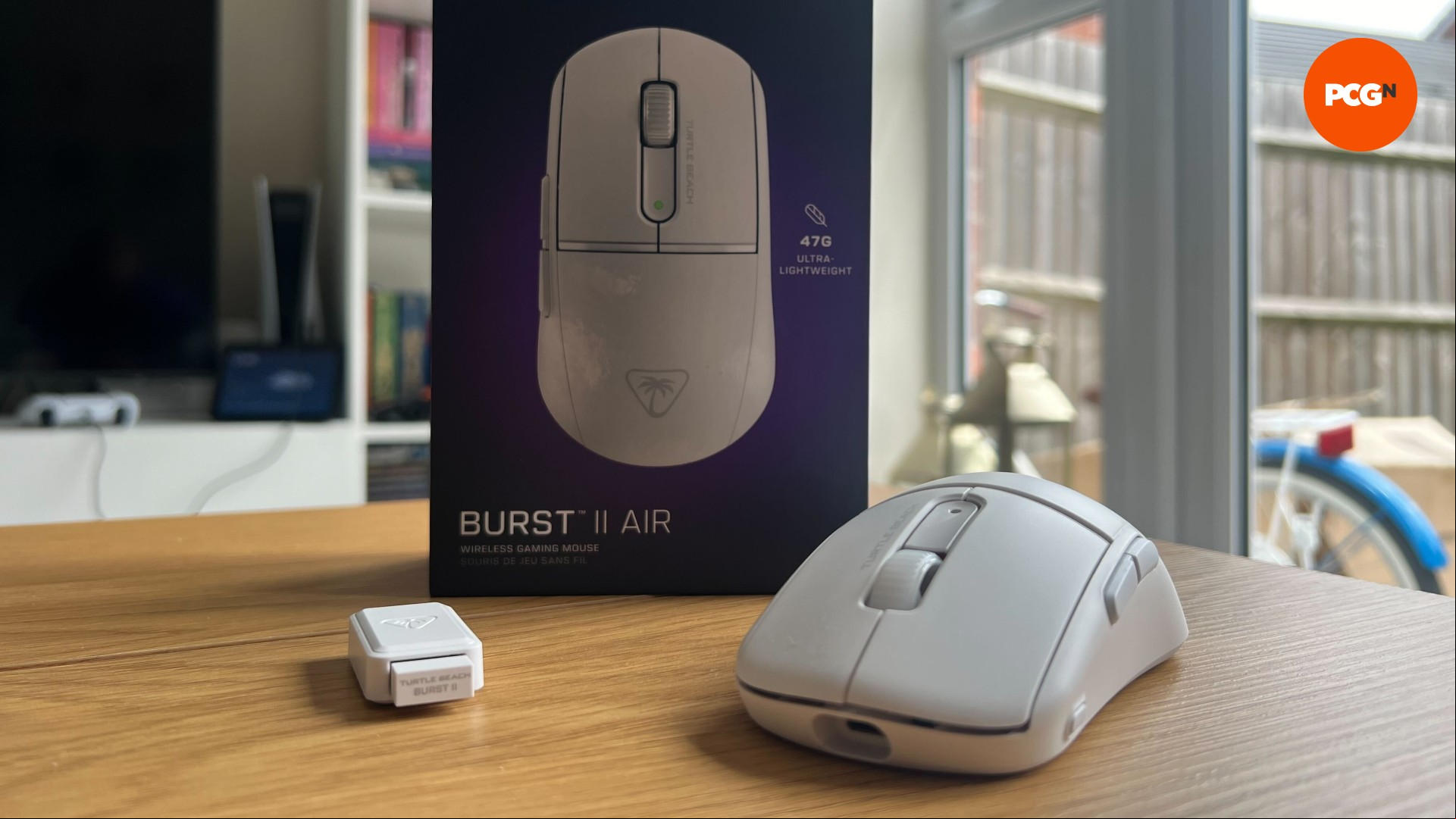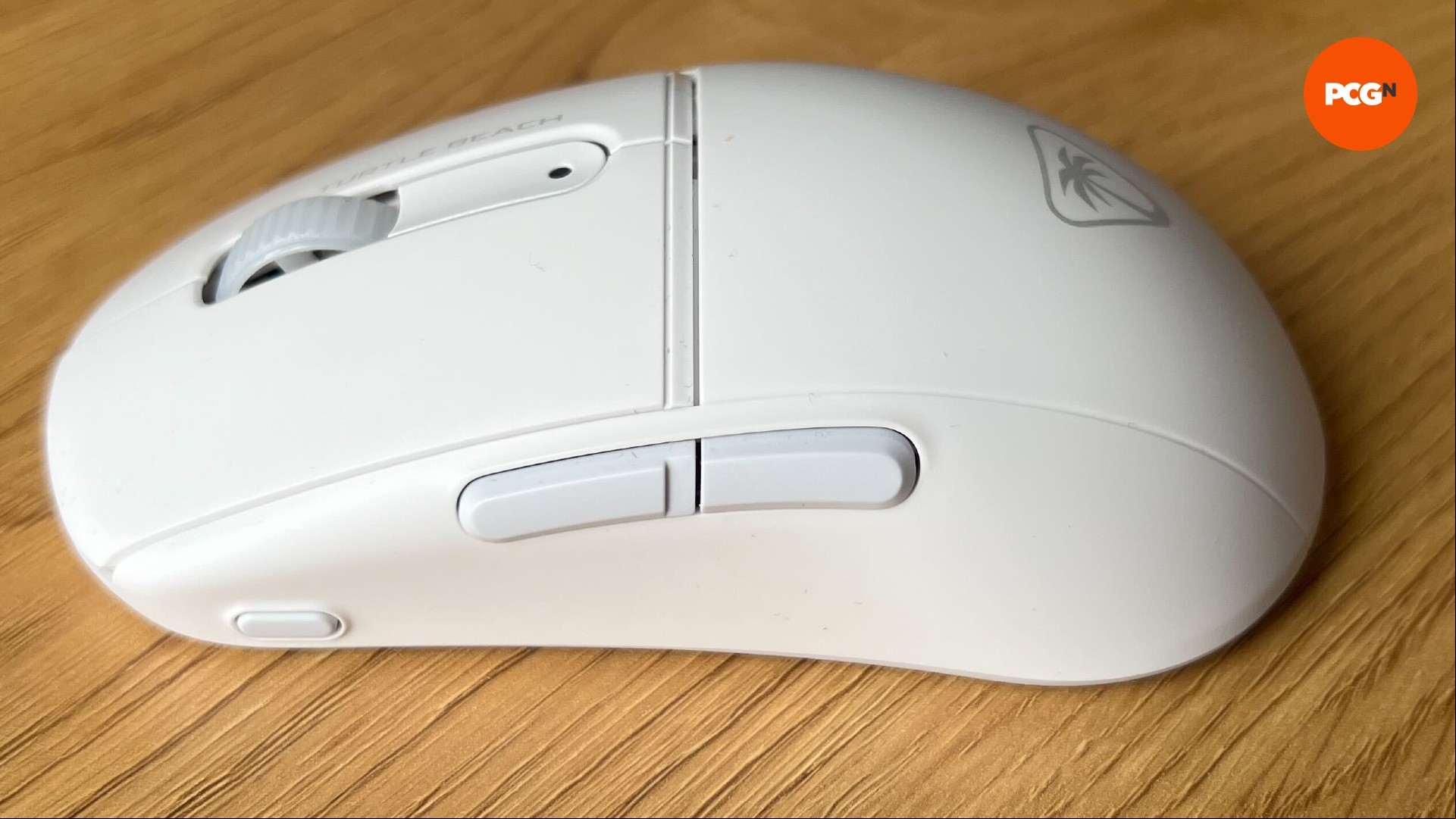Verdict
The Turtle Beach Burst II Air delivers on everything it promises, with an ultralight frame, long-lasting battery, and responsive optical switches. It’s a brilliant first outing for Turtle Beach on the mouse market, and a real contender against much more expensive competition.
- Sleek design
- Ultralight 47g weight
- Swarm software is simple to use
- DPI switch placement
- Max 1,000Hz polling rate
- Hollow feeling build
- Small skates lead to grime build up
Make no mistake, Turtle Beach is taking its PC peripheral lines seriously with its first-ever gaming mouse since folding the Roccat brand. The Burst II Air is a product that's surprisingly light and much more affordable than some big-name competitors, but some potential issues around longevity have me concerned.
Fresh out of the box, the best wireless gaming mice you will find. It's genuinely light at 47g which is a weight that some bigger names in the industry are still unable to get anywhere near. It also has a sleek design that translates well across the black and white models and even manages to include a DPI sensor in a unique, reachable location. All this and you're still spending $50 less than some of its closest rivals.
Why you can trust our advice ✔ At PCGamesN, our experts spend hours testing hardware and reviewing games and VPNs. We share honest, unbiased opinions to help you buy the best. Find out how we test.
Specs
| Sensor | 26K Owl-Eye |
| Battery Life | 120 hours (Bluetooth), 40 hours (2.4GHz) |
| Max DPI | 26,000 |
| Buttons | 6 (8 programmable functions in Swarm) |
| Weight | 47g |

Features
The Turtle Beach Burst II Air is an ultra-lightweight gaming mouse coming in at just 47g which is a remarkably low weight that you can't help but notice. It has six buttons, which can be reassigned into eight varying commands in the Swarm software (the scroll wheel directional inputs can be reconfigured as additional inputs).
You can connect the Burst II Air via Bluetooth, 2.4GHz wireless, or via a USB-C cable. For the 2.4GHz connection, you can use either the standard adaptor or the small transmitter unit that is included in the box. This transmitter also has an adhesive pad on the bottom so you can stick it to your desk if you wish.
The Burst II Air is available in black or white, and the 26K Owl-Eye sensor has a 650 IPS tracking speed while the Titan optical switches are rated for 100 million clicks. The mouse is also Nvidia Reflex compatible making it ideal for competitive shooters.

Design
Turtle Beach takes a simple approach with the design of the Burst II Air, meaning there is still some remnants of the now-defunct Roccat brand when looking purely at the shell design. It has an unassuming symmetrical layout with the brand's palm tree logo sitting where the center of my palm rests against the mouse and Turtle Beach inscribed on the right click up against where the scroll wheel is located. Both of these markings are done in a light grey on the white model, meaning they're subtle and not too noticeable unless you're really paying attention.
The mouse coating has held up well during testing, but the general feel of the plastic shell is quite cheap and hollow to the touch. This is an expected side effect of chasing a lightweight design but other mice have managed to maintain a sturdier feel while being impressively light, even if they haven't been quite as light as this one. This leaves me with concerns over whether the mouse will truly hold up to a lifetime of gamer abuse.
Turtle Beach opts for four small skates, and where larger pads benefited the Razer Viper V3 Pro, the smaller skates work just as well. However, they seem to collect far more dust and detritus from my desk mat. Whether that's due to some sort of static, a touch more adhesive protruding from the edges of pads, or some other peculiarity of these pads is hard to say, but it's definitely not ideal. Thankfully, a spare set of larger pads and a set of grips are included in the box.

Performance
The Turtle Beach Burst II Air glides around my desktop with ease thanks to its 47g weight and its buttons are super responsive, which can be attributed to the pre-tensioned optical click switches. A 26K Titan optical sensor powers the mouse, and as we've come to expect with modern gaming mice, it works flawlessly in general tracking tests on a conventional mouse pad.
It's a shame to see the Burst II Air top out at a 1,000Hz polling rate, especially as I've seen considerable improvement in 2,000Hz and 4,000Hz mice when tested. While not every gaming mouse needs to be capable of 8,000Hz – the max currently available in a gaming mouse – it's a 'nice-to-have' if you're pushing for peak performance at times.
You can customize the Burst II Air using the Swarm software, which is delightfully simple to use and does a great job of keeping firmware up to date. You can use Swarm to set up your DPI profiles and edit the number of active DPI profiles you have, with a maximum of five in total.
You can also lower the polling rate to 125Hz, 250Hz, and 500Hz. You can even adjust the debounce time, allowing for more time to reduce the risk of accidental double clicks or lower it to create faster signal recognition.
Swarm also allows you to play around with the assignments for all the buttons on the mouse, including the scroll wheels' directional inputs. If you're using a Turtle Beach keyboard with the Easy Shift feature, such as the Vulkan II TKL Pro, you can also layer inputs onto every button, essentially doubling the number of inputs you have without the need for extra physical buttons. The Burst II Air also has enough onboard storage for five profiles so you can set up specific profiles for certain games and tasks.
Battery Life
When using the Burst II Air via Bluetooth you can expect up to 120 hours of battery life, an impressive number although this likely won't be your chosen connection method. Like many gaming mice, power is conserved when using this connection type, and if you instead use it via 2.4GHz, the battery life drops down to just 40 hours of continuous use. That's on the shorter side when compared to the likes of the Corsair M75 Air or Razer Viper V3 Pro. This is somewhat offset by a fast charging time, but it seems like a smaller internal battery may have been chosen to keep the overall weight down.
You can extend the battery life in 2.4GHz mode by lowering the standby timer in the Swarm software to ensure there's limited idle draining, but obviously this isn't much use for increasing active gaming time. We also found the Bluetooth mode decently responsive, so you could consider switching to Bluetooth mode to lengthen battery life for desktop use, though again it's not a mode we'd recommend for playing any sort of game where peak response and performance are required.
Price
The Turtle Beach Burst II Air has an MSRP of $99.99 and is available from the Turtle Beach website as well as Amazon and Best Buy. Many competitors price their products around the $120-$150 mark, meaning the Buirst II Air represents a considerable saving while also offering a choice of colors.
The absence of a high polling rate is a factor when it comes to value here, but overall if you're not planning to use it for competitive shooters, it's a feature well worth ing on to save a fair chunk of cash.
Verdict
I'm impressed by the Turtle Beach Burst II Air, and it is a genuine contender against similar gaming mice despite its polling rate restrictions and design quirks. For $99.99, you're getting a stylish, responsive, and light gaming mouse that is a great first step for Turtle Beach in the mouse market, even if it stands on the shoulders of its Roccat predecessors.
Alternatives
Razer Viper V3 HyperSpeed
A light frame, high polling rate, and symmetrical design are all stables of the Viper line of mice, and the V3 HyperSpeed is still one of the best value options given it has an MSRP of just $69.99. The downside is that it's battery-operated, and this does increase the weight considerably, despite it still sitting below the 85g mark.
Corsair M75 Wireless
For a truly symmetrical design, including removable and programmable buttons on both sides of the mouse, the Corsair M75 Wireless is the only design worth considering. It also has a long-lasting battery life and RGB light points which can be customized in iCUE.
